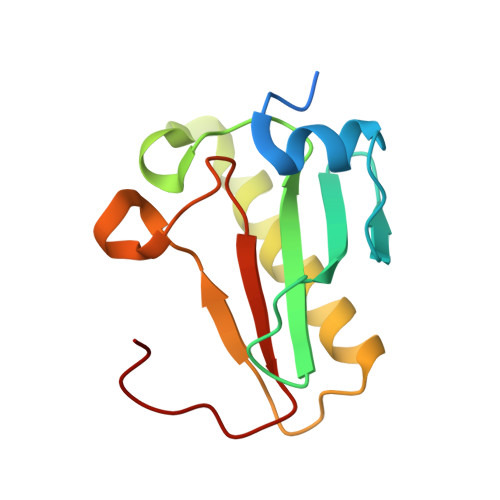Biochemical, crystallographic, and mutagenic characterization of hint, the AMP-lysine hydrolase, with novel substrates and inhibitors
Krakowiak, A.K., Pace, H.C., Blackburn, G.M., Adams, M., Mekhalfia, A., Kaczmarek, R., Baraniak, J., Stec, W.J., Brenner, C.(2004) J Biological Chem 279: 18711-18716
- PubMed: 14982931
- DOI: https://doi.org/10.1074/jbc.M314271200
- Primary Citation of Related Structures:
1RZY - PubMed Abstract:
Hint, histidine triad nucleotide-binding protein, is a universally conserved enzyme that hydrolyzes AMP linked to lysine and, in yeast, functions as a positive regulator of the RNA polymerase II C-terminal domain kinase, Kin28. To explore the biochemical and structural bases for the adenosine phosphoramidate hydrolase activity of rabbit Hint, we synthesized novel substrates linking a p-nitroaniline group to adenylate (AMP-pNA) and inhibitors that consist of an adenosine group and 5'-sulfamoyl (AdoOSO(2)NH(2)) or N-ethylsulfamoyl (AdoOSO(2)NHCH(2)CH(3)) group. AMP-pNA is a suitable substrate for Hint that allowed characterization of the inhibitors; titration of each inhibitor into AMP-pNA assays revealed their K(i) values. The N-ethylsulfamoyl derivative has a 13-fold binding advantage over the sulfamoyl adenosine. The 1.8-A cocrystal structure of rabbit Hint with N-ethylsulfamoyl adenosine revealed a binding site for the ethyl group against Trp-123, a residue that reaches across the Hint dimer interface to interact with the alkyl portion of the inhibitor and, presumably, the alkyl portion of a lysyl substrate. Ser-107 is positioned to donate a hydrogen bond to the leaving group nitrogen. Consistent with a role in acid-base catalysis, the Hint S107A mutant protein displayed depressed catalytic activity.
- Structural Biology and Bioinformatics Program, Kimmel Cancer Center, Philadelphia, Pennsylvania 19107, USA.
Organizational Affiliation:

















